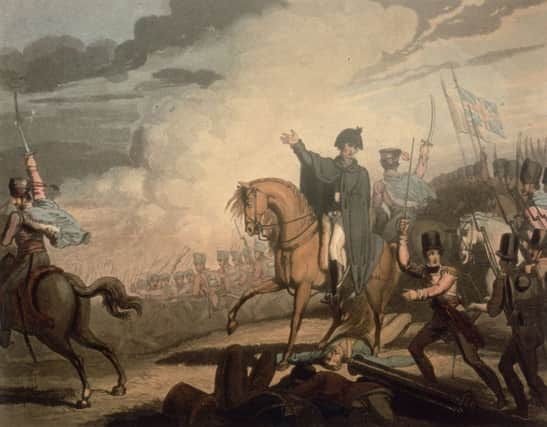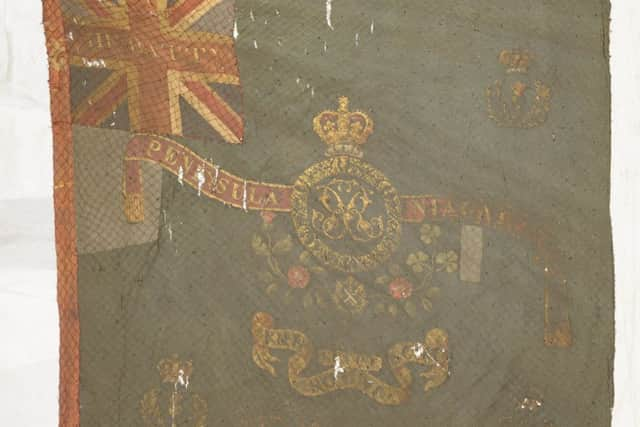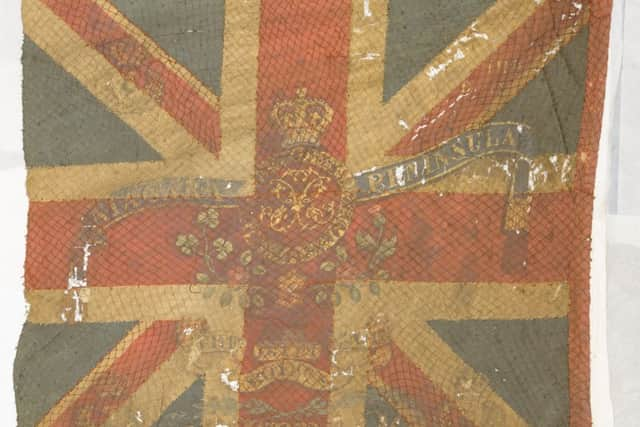Rare sight of flags Scots died for at Waterloo


The two fragile flags will be taken out of storage for the first time in more than 80 years and given pride of place at Edinburgh Castle to coincide with the 200th anniversary of the famous defeat of Napoleon.
They will be going on display in the castle’s great hall between May and August, before being archived forever to ensure they can be properly preserved.
Advertisement
Hide AdTheir display, in specially created glass-covered cases, will celebrate the bravery of the four officers and regimental sergeant-major who were killed trying to prevent them being captured by the French.


A particular focus will be on James Grant Kennedy, the 16-year-old son of an Inverness physician, who is reputed to have had such a tight grip on the “pike” of the Union Jack colour that a sergeant who tried to retrieve it had to carry both the soldier and the flag over his shoulder.
A French commander was said to have been so impressed by this act of gallantry that he ordered his troops to hold fire temporarily. But when the colour was passed to another sergeant he was “shot through the heart”.
The 6ft by 6ft colours of the 3rd Battalion of the Royal Scots – Britain’s oldest army regiment until its controversial demise in 2006 – are in such a fragile state that they have not been seen since they were taken off public display at St Giles Cathedral in Edinburgh’s Royal Mile in 1934.
A spokesman for Historic Scotland said: “These colours have survived many battles. But the centuries-old silk is now so fragile that this will be the final time that they will be on public display, marking the bicentenary of Waterloo.”


The oldest infantry regiment in the British Army can be traced back to the origins of the Royal Scots in 1633, when Sir John Hepburn, under a royal warrant granted by King Charles I, raised a body of men in Scotland for service in France. By 1635 he commanded a force of more than 8,000 troops.
Advertisement
Hide AdThe colours, one King’s and one Regimental, which are going on display at Edinburgh Castle from 2 May until the end of August, are believed to date back to around 1805, the year after the 3rd battalion was raised at Hamilton, in Lanarkshire.
They are thought to have been carried into battle at Corunna, Salamanca, Vittoria St Sebastian and Quatre Bras, the latter of which was fought just two days before the 67,000 allied forces led by the Duke of Wellington defeated Napoleon’s French army at Waterloo. The final two battles cost the Royal Scots battalion 363 casualties out of 624 troops.
Advertisement
Hide AdColonel Robert Watson, chair of the Royal Scots Regimental Museum at the castle, said: “There can be few, if any, colours still in existence which saw or reflect so much action in such important campaigns and battles over such a key period in Europe’s history.
“The colours are three times the size of those carried on parade today.
“You cannot but admire how the average, mostly teenage and much smaller, junior officers of those days carried them, and were often killed while doing so, through the heat, shot, shell and sheer terror of the battles, often lasting a full day.”
Hugh Morrison, collections registrar at Historic Scotland, said: “It’s a very rare opportunity indeed to see them because of their fragility and size.”
Napoleon’s nemesis: ‘nearest run thing’
The Battle of Waterloo on 18 June, 1815, was the decisive engagement of the Waterloo Campaign and the last battle to be fought by Napoleon Bonaparte.
The battlefield in Belgium, just over a mile from the town of Waterloo, saw the French army under Napoleon defeated by an Anglo-allied army commanded by the Duke of Wellington combined with a Prussian army under the command of Gebhard von Blücher.
Advertisement
Hide AdNapoleon had attacked in a bid to destroy the enemies who had gathered armies in their opposition to his return to power before they could join in a co-ordinated invasion of France. The Duke of Wellington said the battle was “the nearest-run thing you ever saw in your life” and swung on the arrival of the Prussian army, which broke Napoleon’s right flank and turned the tide of the battle.
Wellington had earlier written letters saying without the support of the Prussian forces he would not give battle, but would retreat towards Brussels. The Prussian army had been forced to regroup after a heavy defeat by the French at Ligny.
Advertisement
Hide AdThe battle ended with some 49,000 dead or injured after ferocious fighting.
The defeat at Waterloo ended Napoleon’s rule as Emperor of the French, and he eventually surrendered to Captain Maitland of HMS Bellerophon, part of the British blockade, and was exiled to Saint Helena where he died in 1821.
Today the site of the battlefield is dominated by a large monument, the Lion’s Mound.
FOLLOW US
SCOTSMAN TABLET AND MOBILE APPS